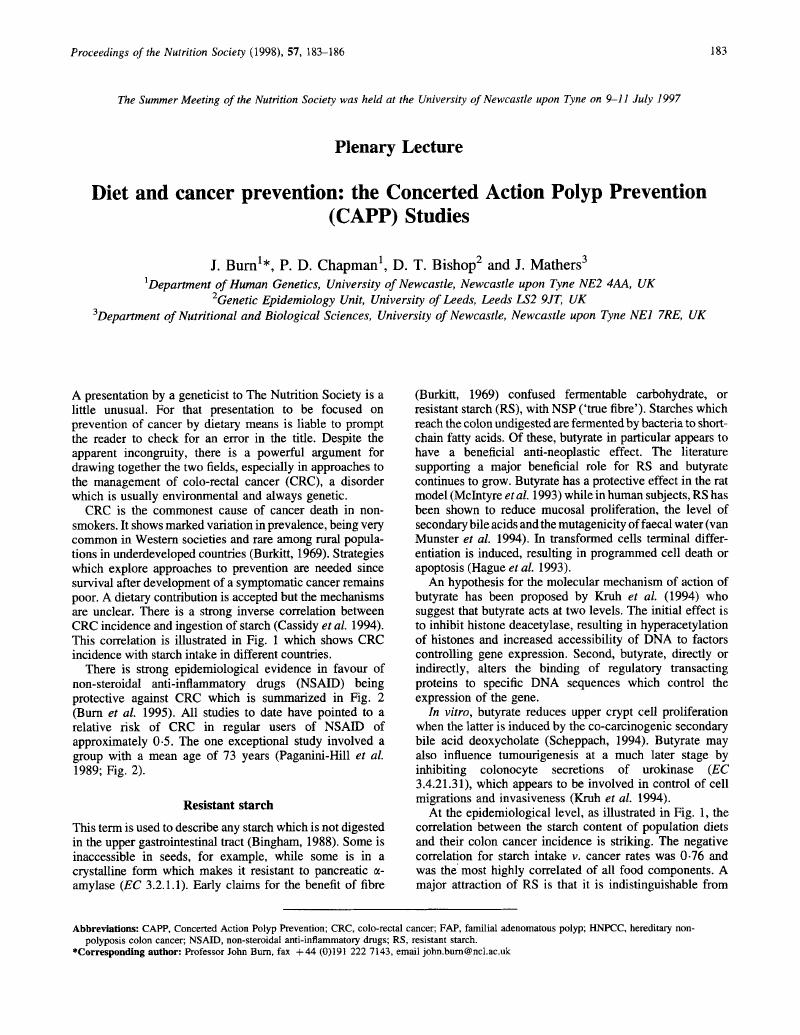Crossref Citations
This article has been cited by the following publications. This list is generated based on data provided by Crossref.
Mathers, John C.
and
Burn, John
1999.
Nutrition in cancer prevention.
Current Opinion in Oncology,
Vol. 11,
Issue. 5,
p.
402.
Adamson, Ashley
Curtis, Peter
Loughridge, Jane
Rugg‐Gunn, Andrew
Spendiff, Anne
and
Mathers, John
2000.
A family‐based intervention to increase consumption of starchy foods.
Nutrition & Food Science,
Vol. 30,
Issue. 1,
p.
19.
Mathers, John C.
2000.
Dietary Anticarcinogens and Antimutagens.
p.
395.
Armstrong, Fiona
and
Mathers, J. C.
2000.
Kill and cure: dietary augmentation of immune defences against colon cancer.
Proceedings of the Nutrition Society,
Vol. 59,
Issue. 2,
p.
215.
Saletti, P.
Edwin, I. Dove
Pack, K.
Cavalli, F.
and
Atkin, W.S.
2001.
Microsatellite instability: Application in hereditary non-polyposis colorectal cancer.
Annals of Oncology,
Vol. 12,
Issue. 2,
p.
151.
Dove‐Edwin, I.
and
Thomas, H. J. W.
2001.
The prevention of colorectal cancer.
Alimentary Pharmacology & Therapeutics,
Vol. 15,
Issue. 3,
p.
323.
Emery, Jon
Lucassen, Anneke
and
Murphy, Michael
2001.
Common hereditary cancers and implications for primary care.
The Lancet,
Vol. 358,
Issue. 9275,
p.
56.
Fearnhead, Nicola S
Wilding, Jennifer L
and
Bodmer, Walter F
2002.
Genetics of colorectal cancer: hereditary aspects and overview of colorectal tumorigenesis.
British Medical Bulletin,
Vol. 64,
Issue. 1,
p.
27.
Peleg, Ika I.
and
Mel Wilcox, C.
2002.
The Role of Eicosanoids, Cyclooxygenases, and Nonsteroidal Anti-inflammatory Drugs in Colorectal Tumorigenesis and Chemoprevention.
Journal of Clinical Gastroenterology,
Vol. 34,
Issue. 2,
p.
117.
Mathers, John C.
2002.
Pulses and carcinogenesis: potential for the prevention of colon, breast and other cancers.
British Journal of Nutrition,
Vol. 88,
Issue. S3,
p.
273.
Champ, Martine
Langkilde, Anna-Maria
Brouns, Fred
Kettlitz, Bernd
and
Bail-Collet, Yves Le
2003.
Advances in dietary fibre characterisation. 2. Consumption, chemistry, physiology and measurement of resistant starch; implications for health and food labelling.
Nutrition Research Reviews,
Vol. 16,
Issue. 2,
p.
143.
Mathers, John C.
Mickleburgh, Ian
Chapman, Pam C.
Bishop, D. Tim
and
Burn, John
2003.
Can resistant starch and/or aspirin prevent the development of coloi neoplasia? The Concerted Action Polyp Prevention (CAPP) 1 Study.
Proceedings of the Nutrition Society,
Vol. 62,
Issue. 1,
p.
51.
Taylor, C.F.
Charlton, R.S.
Burn, J.
Sheridan, E.
and
Taylor, G.R.
2003.
Genomic deletions inMSH2 orMLH1 are a frequent cause of hereditary non-polyposis colorectal cancer: Identification of novel and recurrent deletions by MLPA.
Human Mutation,
Vol. 22,
Issue. 6,
p.
428.
Müller, Hansjakob
Plasilova, Martina
Russell, Anna Marie
and
Heinimann, Karl
2003.
Tumor Prevention and Genetics.
Vol. 163,
Issue. ,
p.
235.
Hawk, Ernest T.
Umar, Asad
and
Viner, Jaye L.
2004.
Colorectal cancer chemoprevention—an overview of the science1 1This article was prepared in our capacity as employees of the U.S. Federal Government..
Gastroenterology,
Vol. 126,
Issue. 5,
p.
1423.
van der Klift, Heleen
Wijnen, Juul
Wagner, Anja
Verkuilen, Paul
Tops, Carli
Otway, Robyn
Kohonen‐Corish, Maija
Vasen, Hans
Oliani, Cristina
Barana, Daniela
Moller, Pal
DeLozier‐Blanchet, Celia
Hutter, Pierre
Foulkes, William
Lynch, Henry
Burn, John
Möslein, Gabriela
and
Fodde, Riccardo
2005.
Molecular characterization of the spectrum of genomic deletions in the mismatch repair genes MSH2, MLH1, MSH6, and PMS2 responsible for hereditary nonpolyposis colorectal cancer (HNPCC).
Genes, Chromosomes and Cancer,
Vol. 44,
Issue. 2,
p.
123.
Rawl, Susan M.
Champion, Victoria L.
Scott, Linda L.
Zhou, Honghong
Monahan, Patrick
Ding, Yan
Loehrer, Patrick
and
Skinner, Celette Sugg
2008.
A randomized trial of two print interventions to increase colon cancer screening among first-degree relatives.
Patient Education and Counseling,
Vol. 71,
Issue. 2,
p.
215.
Klinder, Annett
Glei, Michael
and
Pool-Zobel, Beatrice
2008.
Handbook of Prebiotics.
p.
295.
Burn, John
2011.
Chemoprevention.
Viszeralmedizin,
Vol. 27,
Issue. 4,
p.
322.
Burn, John
Mathers, John C.
and
Bishop, D. Tim
2013.
Chemoprevention in Lynch syndrome.
Familial Cancer,
Vol. 12,
Issue. 4,
p.
707.



